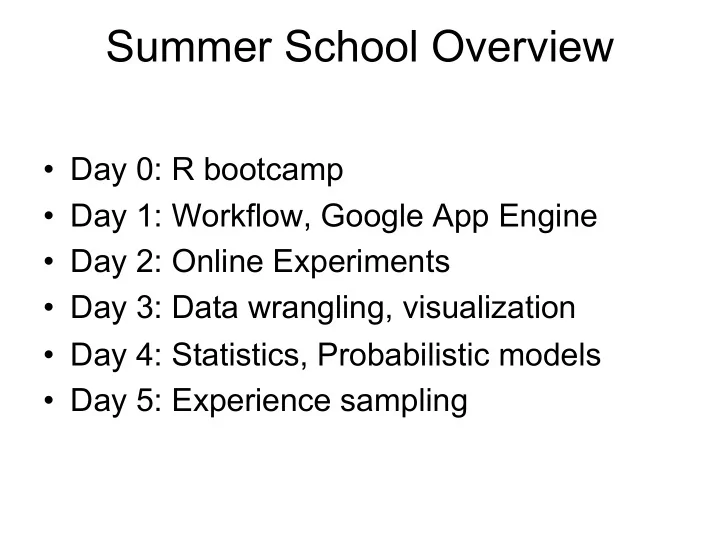

Summer School Overview • Day 0: R bootcamp • Day 1: Workflow, Google App Engine • Day 2: Online Experiments • Day 3: Data wrangling, visualization • Day 4: Statistics, Probabilistic models • Day 5: Experience sampling
Packages and programs Please install the lme4, brms, tidybayes and BayesFactor packages in R, along with JAGS (see link on resources page of website)
Announcements
Day 4 materials • Update your copy of the chdss2019_content repository (type git pull at the terminal when working directory is Desktop/chdss2019_content) Open chdss2019_content.Rproj
Goals 1. Introduce some statistical concepts, including Bayesian approaches and mixed effects models 2. Work towards a statistical analysis of the sampling frames data
Classical tests
tinyframes data
tinyframes data
t-test
From a t-test to linear models mod1 : mod2 :
From a t-test to linear models mod1 : mod2 :
ANOVA for model comparison mod1 : mod2 :
Least squares regression
Coughing patient • d : Jen is coughing • h 1 : Jen has a cold h 2 : Jen has emphysema h 3 : Jen has a stomach upset Evidence Posterior Prior (Likelihood) probability knowledge P(h|d) = P(d|h) P(h) P(d)
Coughing patient • d : Jen is coughing • h 1 : Jen has a cold h 2 : Jen has emphysema h 3 : Jen has a stomach upset Evidence Posterior Prior (Likelihood) probability knowledge P(h|d) α P(d|h) P(h)
Specifying prior and likelihood
prior likelihood posterior
Exercise: Coughing patient
Bayesian inference Two distinct applications: 1. Bayesian Data analysis 2. Bayesian cognitive models
Bayesian regression M 1 : M 2 : Both models assume Fitting M 2 : compute where D is the observed data
Bayesian regression prior likelihood posterior
Bayesian inference prior Assume
Bayesian inference likelihood
Bayesian inference likelihood
Bayesian inference likelihood …
Bayesian inference prior posterior
Markov-Chain Monte Carlo (MCMC) methods
Regression • Least-squares: • Bayesian:
Bayes factors for model comparison M 1 : M 2 :
Bayes factors for model comparison M 1 : M 2 :
Bayes factors for model comparison
Bayes factors for model comparison mod1 : mod2 :
Multiple predictors
Multiple predictors mod3 : Model selection:
Model comparison with AIC and BIC For model with parameters Find that maximizes AIC : BIC : where k is number of parameters, n is number of data points
Model comparison with AIC and BIC Find that maximizes AIC : BIC : where k is number of parameters, n is number of data points Important points: - lower is better - both penalize model complexity (BIC has heavier penalty)
Model comparison with AIC and BIC
Mixed effects models • ANOVA models used to be the go-to approach in psychology, but the field is shifting to mixed-effects models. • Advantages of mixed-effects models: – extend naturally to complex situations (e.g. cases with nested structure, factors that overlap in complex ways) – deal well with missing data
Sleep study example
Fixed intercept, slope
Random intercept per group
Random slope per group
Random slope + intercept per group
Mixed effects models
Exercise
modestframes data
Model comparison anova(modest1, modest2, modest3)
Model checking: individuals
Model checking: predictions
Model checking: residuals
frames data
Model comparison linframes1: linframes2 : anova(linframes1, linframes2)
Model checking: individuals
Generalized linear mixed models Map response to generalization (between 0 and 1)
What to write up? • The actual paper reported Bayes factors computed using JASP • See analysis_samplesize.Rmd (in samplingframes/analysis) for more
Recommend
More recommend